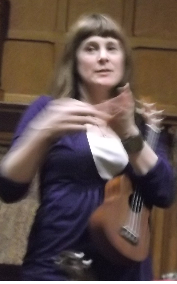I grew up in Hawaii, and we almost took for granted that as island children we would own ukuleles, and that those of us blessed to live in West Kauai would take lessons with Charlie Kaneyama. And so it happened in my childhood. Inevitably, as I grew up, over the succeeding years I traveled thousands of miles from home and moved umpteen times, and eventually my ukulele disappeared. When I think back to those years, I’m sure I enjoyed the instrument. But I’m not a musician and never thought much more about the ukulele, until today.
 At 6 pm, about twenty of us gathered in North Brookfield’s Haston Free Public Library for a first lesson in playing the ukulele. Originally from Nebraska, our teacher Julie, a lovely and vibrant young musician, came to us from her home in Shutesbury with twenty ukuleles, so we each took one and sat down. She began by showing us the parts of the ukulele and how to hold it. (I apologize for the photo quality.)
At 6 pm, about twenty of us gathered in North Brookfield’s Haston Free Public Library for a first lesson in playing the ukulele. Originally from Nebraska, our teacher Julie, a lovely and vibrant young musician, came to us from her home in Shutesbury with twenty ukuleles, so we each took one and sat down. She began by showing us the parts of the ukulele and how to hold it. (I apologize for the photo quality.)
The basic parts of the ukulele are the following:
- hollow body with sound hole
- neck with frets and metal fret dividers – each fret is a half tone
- nylons strings, tuned to C, G, E, A (facing the instrument)
Ukuleles, like all musical instruments, need to be tuned; a tuner can be purchased for around $10.
Because the ukulele is small and doesn’t weigh much, you don’t need a strap to hold it. Keep it near your body, holding it in place with your right arm. Open your left palm and grasp the neck near the top, as if you were clutching a soda can. There are different techniques for strumming and no one right way. You could try to move your right hand as if it were wet and you were flicking water. Strum the strings a little above the sound hole. In order to form a chord, curve your four fingers around the neck and press the tips, not the pads, on the frets.
Chords are defined for the western harmonic scale; these include the major, minor, and seventh chords. Using Julie’s fingering charts, we learned:
- C
- G7
- F
- Am
Then we began to sing and play! Over the course of the evening, we played these songs:
2-chord songs:
- Frere Jacques
- Locomotion
- Singing in the Rain
- Doggie in the Window
- Ain’t No Bugs on Me
3-chord songs:
- You Are My Sunshine
- Oh Susanna
- Good Night Irene
Julie stressed that you ought to enjoy playing. Fortunately, she said, the ukulele is much lighter in weight than the guitar and doesn’t have steel strings that will cut your fingers. If you play for even ten minutes a day, perhaps adding a new chord every so often, you can quickly add literally hundreds of songs to your repertoire.
Toward the end of the lesson, Julie introduced the Australian comedy group called the Axis of Awesome; this group created a hit song using the basic chord sequence C, G, Am, and F, which they demonstrated was the basis of many popular songs.
I had so much fun singing and playing that I asked Julie where I could buy a ukulele. She talked a bit about cost and advised against paying less than $50 for an instrument (of course, you could easily spend hundreds). Some of the currently popular brands for beginners include Lanikai Ukulele and Makala Ukulele (the one I used tonight was a Kala). When I’m next in Northampton, I might stop in at Downtown Sounds to check out their selection, as they are local and would be available to help with tuning or any other problems I might run into.